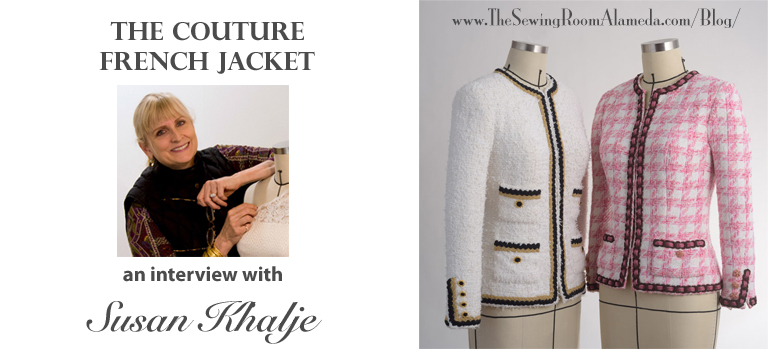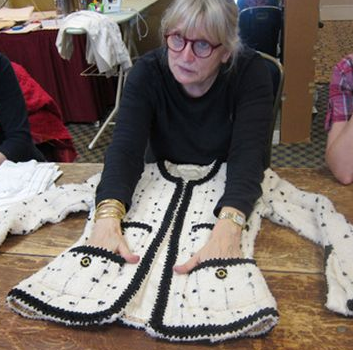Just a little background - My own French Couture Jacket has been "In the Works" for over 5 years now. Ugh. I had planned to post this months ago, when I interviewed Susan in March. Procrastination set in, however, and then my Summer Season took over. Now, I'm committed! and I'm going to finish. I WON'T start anything new until this is hanging, FINISHED, in my closet. Wish me luck! There is lots of handwork and concentration involved. So, I'm going to need your support and accountability...
I've been looking to finish my own "French (Chanel inspired) Jacket" this year so I turned to an expert for some inspiration and encouragement in doing so. Susan Khalje is THE expert and has been making, teaching how to make and writing about making these Iconic pieces for many years. She is also my own Couture instructor and I relish every minute I've had with her over the years. Here is a conversation we had about her experience teaching about and wearing this amazing piece of clothing. I hope you enjoy her answers as much as I did and I hope you get a chance to take one of her classes someday. Enjoy!
Jennifer: How & When did you first become aware of the Chanel Jacket and it’s status as a fashion Icon?
Susan: Well, I think if you're involved in fashion in any way, you're pretty much aware of the Chanel jacket - it's been around forever, it seems. And as a child of the 60's, I do remember Jackie Kennedy wearing them, and always looking so chic. And my mother - the world's biggest Francophile - would come back from Paris with fashion magazines, and of course, they were always featured there. And that was in the 60's as well, when I was really getting into sewing, so they were always - to a greater or lesser degree - part of the inspiration of the whole world of fashion and sewing. And of course, the marvelous thing about them is how they've changed with the times. People are always saying, when you mention Chanel jackets, "Oh, no, that's not my style - those boxy jackets." Well, they're not boxy anymore - they're very form-fitting, and beautifully shaped with all of those seams. This is not your grandmother's jacket.
Jennifer: How long have you been studying the construction and process of making this “Chanel” style cardigan jacket?
Susan: I first starting making them when I worked at Chez Cez et Bez in New York. It was a small couture house, and of course, we had clients who had plenty of the real thing, and that, really, was where I first saw and became familiar with the haute couture versions, and they informed a lot of the work we did in that area. And since then, I've written about the subject, and taught an awful lot of jacket classes. So it's fun when challenges and variations present themselves - I've fitted all shapes and sizes, and helped students find the best fabric/trim/button options, so my experience has grown enormously, too.
Jennifer: What are 3-5 features of the cardigan jacket, that make it special?
Susan: Everything, really - and I do think it starts with the fact that if the jacket is well-fitted, it looks great on just about everyone. Plus, it's easy to dress up or dress down - it can go to the opera, it can go to the grocery store, and everywhere in-between. And it travels beautifully. And lasts forever. It's pretty hard to wear one of these out.
So - features? It's just a wonderful combination of fabric + design + trims + buttons - and once you get the balance right, it all just somehow works together. And of course, there is that wonderful 3-piece sleeve (which, I have to say, is just beautifully drafted on our Classic French Jacket Pattern - what a lot of work we did on that!) and all of its advantages: the ability to shape the top of the sleeve along that extra seam line, and the perfect placement of the sleeve vent.
Jennifer: Of all the jacket’s you’ve made over the years, do you have one for yourself that you wear regularly?
Susan: Everyone always thinks that I have dozens of them, but in fact, I only have about 4 or 5 - and I wear them a lot. I have one that's grey, so it's perfect for more serious occasions; I have a black one with gold trim that's pretty fancy; I have a really warm beige/lavender/grey plaid one that I wear all the time in the winter; I have a longer black one that works with everything......and I just brought a lovely piece of Chanel fabric back from Paris - it's beige with a sort of subtle check - if I ever find the time, I'll do that one next. It would span the seasons, I think, so it would be really useful.
Jennifer: Along the same lines, do you have a favorite jacket that you’ve made for yourself or someone else or for display that is your favorite? What makes it your favorite? Fabric, trims, versatility?
Susan: I guess the one that was used for the Threads article - it was the cover article for the 20th Anniversary Issue - is a favorite, partly because everyone recognizes it, and it looks great on everyone (it's a teaching sample, and people are always trying it on.) The fabric is great - it was from Mendel Goldberg in New York. It's ivory, with black threads through it and black and grey bobbles in there; the trim (black) and buttons (black and gold) were from B&J - it somehow all just balances really nicely. It's pretty classic.
Jennifer: I see that you now teach the “French Jacket” Technique both online and in person. I realize there is a considerable price difference between working with you in person and following a course online, but would you let our readers know any particular differences between the format? Pros and cons of online vs. in person?
Susan: Well, to my mind, there are two tricky things about the process: fitting the muslin (always a challenge), and hanging the sleeves (also a challenge to do really well). And you know as well as I do that it's hard to do both of those on yourself. So - the advantage of coming to the class is that I do those things for my students. And I've fitted an awful lot of jackets and hung an awful lot of sleeves. So, you've got an expert doing that. But - the advantage of the video is that you can play it over and over, a million times, and really let the knowledge sink in. And, with patience, you can fit the muslin and get the sleeves hung.
So there are advantages to both approaches. And I have to say, the class is pretty intense - we're limited to 7 days, so there's a lot of accomplish; with the video, you can take your time. Then again, in class, you've got camaraderie, you've got inspiration from the other students, you've got my advice when we go to New York to shop for fabrics and trims and buttons, you've got access to my collection of vintage Chanel trims, so that's all great.......but, I don't teach that many sessions of it, and it's not inexpensive. I recognize that. Which is why I made the video as comprehensive as I possibly could.
I've been working on my Jacket using the Claire Shaeffer book but I think it might just be time for me to take Susan's online class.
Jennifer: I’ve been working on a French Cardigan Jacket for the last few years. Do you have any encouraging words for my finishing it this year?
Susan: I know the feeling! But I have to ask - what's the hold up? (Other than not enough hours in the day!) Are you less-than-thrilled with the trim, for instance? Maybe new trim and buttons would give it a bit of a jump start? I sometimes finish something up when I need it for a special occasion - maybe you can find a deadline for yourself!!! I made one once in 4 days, only because I had to wear it to an event in New York. It was quite the motivator!!!
(Yikes! I better get cracking!)
Jennifer: While I’m giving this interview, you are teaching in Australia. Tell us more about your experience Down Under and what you are teaching there?
Susan: Classes start Monday! I've had lots of Australian students over the years, and they've always asked me to come here to teach - so, with some help from my friend (and student) Melanie Anderson (from Melbourne), and the help of the Australian Sewing Guild (getting my visa, and finding venues in Sydney and Brisbane), I decided it was time to take the plunge. Classes filled pretty quickly - I'm teaching 3 Couture Sewing School sessions, 2 Classic French Jacket classes, 2 Guipure Lace Skirt classes, and 3 Couture Techniques classes. Quite the undertaking!!!! I can't teach in Baltimore during the winter (the weather's too iffy for out-of-town students), so this just might be a good alternative!!!
Thank you Susan! You amaze and astound me with your energy and enthusiasm and your deep understanding of the work you do.
Find out more about Susan and her French Jacket courses on her website - www.SusanKhalje.com





